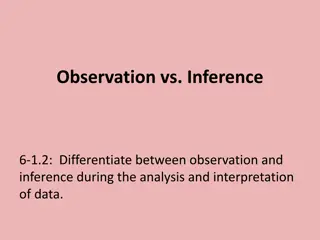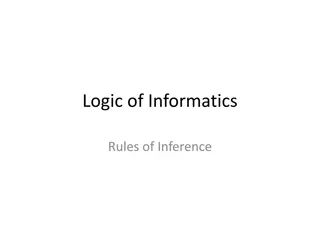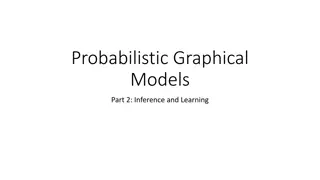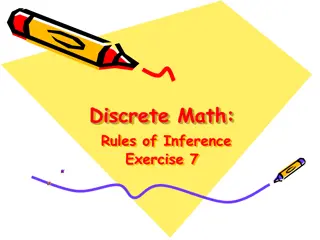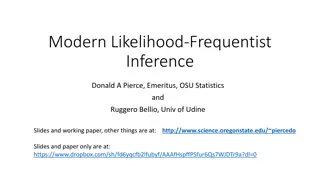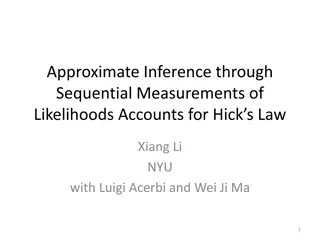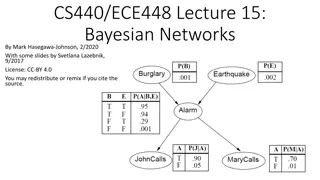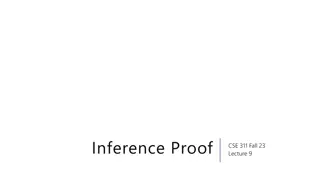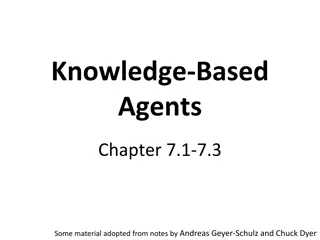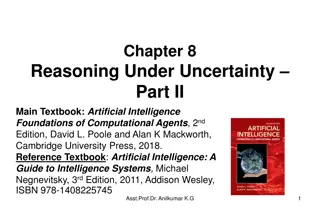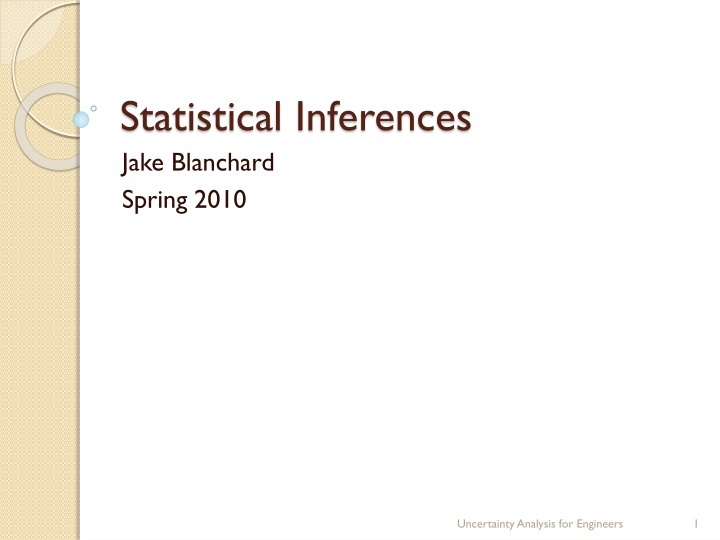
Uncertainty Analysis in Statistical Inferences for Engineers
Learn about the process of statistical inference including parameter estimation, properties of estimators, point estimation, and different types of estimators like maximum likelihood. Explore the significance of uncertainty analysis in engineering applications.
Uploaded on | 2 Views
Download Presentation

Please find below an Image/Link to download the presentation.
The content on the website is provided AS IS for your information and personal use only. It may not be sold, licensed, or shared on other websites without obtaining consent from the author. If you encounter any issues during the download, it is possible that the publisher has removed the file from their server.
You are allowed to download the files provided on this website for personal or commercial use, subject to the condition that they are used lawfully. All files are the property of their respective owners.
The content on the website is provided AS IS for your information and personal use only. It may not be sold, licensed, or shared on other websites without obtaining consent from the author.
E N D
Presentation Transcript
Statistical Inferences Jake Blanchard Spring 2010 Uncertainty Analysis for Engineers 1
Introduction Statistical inference=process of drawing conclusions from random data Conclusions of this process are propositions, for example Estimates Confidence intervals Credible intervals Rejecting a hypothesis Clustering data points Part of this is the estimation of model parameters Uncertainty Analysis for Engineers 2
Parameter Estimation Point Estimation Calculate single number from a set of observational data Interval Estimation Determine interval within which true parameter lies (along with confidence level) Uncertainty Analysis for Engineers 3
Properties Bias=expected value of estimator does not necessarily equal parameter Consistency=estimator approaches parameter as n approaches infinity Efficiency=smaller variance of parameter implies higher efficiency Sufficient=utilizes all pertinent information in a sample Uncertainty Analysis for Engineers 4
Point Estimation Start with data sample of size N Example: estimate fraction of voters who will vote for particular candidate (estimate is based on random sample of voters) Other examples: quality control, clinical trials, software engineering, orbit prediction Assume successive samples are statistically independent Uncertainty Analysis for Engineers 5
Estimators Maximum likelihood Method of moments Minimum mean squared error Bayes estimators Cramer-Rao bound Maximum a posteriori Minimum variance unbiased estimator Best linear unbiased estimator etc Uncertainty Analysis for Engineers 6
Maximum Likelihood Suppose we have a random variable x with pdf f(x; ) Take n samples of x What is value of that will maximize the likelihood of obtaining these n observations? Let L=likelihood of observing this set of values for x Then maximize L with respect to Uncertainty Analysis for Engineers 7
Maximum Likelihood ( ) = , ,... ; ( ; ) ( ; )... ( ; ) L x x x f x f x f x 1 2 1 2 n n ( ) = , ,... ; 0 L x x x 1 2 n 0 = ( ) log , ,... ; L x x x 1 2 n Uncertainty Analysis for Engineers 8
Example Time between successive arrivals of vehicles at an intersection are 1.2, 3, 6.3, 10.1, 5.2, 2.4, and 7.2 seconds Assume exponential distribution Find MLE for Uncertainty Analysis for Engineers 9
Solution 1 = / t f e 7 7 1 1 1 = i = i = = / t = i exp L e t t i 7 1 1 7 1 35 3 . = = log( ) 7 ( ) 7 ( ) L Log t Log i 1 log( ) 7 35 3 . 2 L = + = 0 35 3 . = = . 5 04 7 Uncertainty Analysis for Engineers 10
2-Parameter Example Measure cycles to failure of saturated sand (25, 20, 28, 33, 26 cycles) Assume lognormal distribution Uncertainty Analysis for Engineers 11
Solution 2 ln( ) 1 1 x = exp i f 2 2 x i 2 n n ln( ) 1 1 1 1 x 1 2 n x ( ) = i = i = i 2 = = exp exp ln( ) i L x i 2 2 2 2 x 1 1 1 i i 1 2 n n ( ) x ( ) = i = i 2 = ln( ) ln( 2 ) ln( ) ln ln( ) L n n x i i 2 1 1 ln( ) 1 n L ( ) = i n = = ln( ) 0 x i 2 1 ln( ) 1 n L ( ) = i 2 = + = ln( ) 0 x i 3 1 1 n n = i = = ln( ) . 3 26 x i 1 1 n n ( ) = i 2 = = 2 ln( ) . 0 027 x i 1 = . 0 164 Uncertainty Analysis for Engineers 12
Method of Moments Use sample moments (mean, variance, etc.) to set distribution parameters Uncertainty Analysis for Engineers 13
Example Time between successive arrivals of vehicles at an intersection are 1.2, 3, 6.3, 10.1, 5.2, 2.4, and 7.2 seconds Assume exponential distribution Mean=5.05 Uncertainty Analysis for Engineers 14
2-Parameter Example Measure cycles to failure of saturated sand (25, 20, 28, 33, 26 cycles) Assume lognormal distribution Mean=26.4 Standard Deviation=4.72 Solve for and =3.26 =0.177 Uncertainty Analysis for Engineers 15
Solution 2 ln( ) 1 1 x = exp i f 2 2 x i 2 n n ln( ) 1 1 1 1 x 1 2 n x ( ) = i = i = i 2 = = exp exp ln( ) i L x i 2 2 2 2 x 1 1 1 i i 1 2 n n ( ) x ( ) = i = i 2 = ln( ) ln( 2 ) ln( ) ln ln( ) L n n x i i 2 1 1 ln( ) 1 n L ( ) = i n = = ln( ) 0 x i 2 1 ln( ) 1 n L ( ) = i 2 = + = ln( ) 0 x i 3 1 1 n n = i = = ln( ) . 3 26 x i 1 1 n n ( ) = i 2 = = 2 ln( ) . 0 027 x i 1 = . 0 164 Uncertainty Analysis for Engineers 16
Minimum Mean Square Error Choose parameters to minimize mean squared error between measured data and continuous distribution Essentially a curve fit Uncertainty Analysis for Engineers 17
Approach Excel Guess parameters Calculate sum of squares of errors Vary guessed parameters to minimize error (use the Solver) Matlab Use fminsearch function Uncertainty Analysis for Engineers 18
Example Solar insolation data Gather data Form histogram Normalize histogram by number of samples and width of bins Uncertainty Analysis for Engineers 19
Scatter Plot and Histogram 4500 4000 3500 3000 2500 2000 1500 1000 500 0 0 5 10 15 20 25 30 35 12 10 8 6 4 2 0 3500 3700 3900 4100 4300 4500 Uncertainty Analysis for Engineers 20
Normal and Weibull Fits Mean=3980 (fit) Mean=3915 (data) 0.0035 0.003 0.0025 0.002 0.0015 0.001 0.0005 0 0.0035 3500 3700 3900 4100 4300 4500 0.003 0.0025 0.002 0.0015 0.001 0.0005 0 3500 3700 3900 4100 4300 4500 Uncertainty Analysis for Engineers 21
Excel Screen Shot Uncertainty Analysis for Engineers 22
Excel Screen Shot Uncertainty Analysis for Engineers 23
Solver Set Up Uncertainty Analysis for Engineers 24
Matlab Script y=xlsread('matlabfit.xlsx','normal') [s,t]=hist(y,8); s=s/((max(t)-min(t))/8)/numel(y); numpts=numel(t); zin(1)=mean(t); zin(2)=std(t); sumoferrs(zin,t,s) zout=fminsearch(@(z) sumoferrs(z,t,s), zin) sumoferrs(zout,t,s) xplot=t(1):(t(end)-t(1))/(10*numel(t)):t(end); yplot=curve(xplot,zout); plot(t,s,'+',xplot,yplot) Uncertainty Analysis for Engineers 25
Matlab Script function f=curve(x,z) mu=z(1); sig=z(2); f=normpdf(x,mu,sig); function f=sumoferrs(z, x, y) f=sum((curve(x,z)-y).^2); Uncertainty Analysis for Engineers 26
Sampling Distributions How do we assess inaccuracy in using sample mean to estimate population mean? 1 n = = x x i n 1 i 1 1 n ( ) = = = = E x n x i n n 1 i ( ) 2 1 1 1 n n ( ) x = = = = = = 2 Var Var x Var x n i i 2 2 n n n n 1 1 i i = x n Uncertainty Analysis for Engineers 27
Conclusions Expected value of mean is equal to population mean Mean of sample is unbiased estimator of mean of population Variance of sample mean is sampling error By CLT, sample mean is Gaussian for large n Mean of x is N( , / n) Estimator for improves as n increases Uncertainty Analysis for Engineers 28
Sample Mean with Unknown In previous derivation, is the population mean This is generally not known All we have is the sample variance (s2) If sample size is small, distribution will not be Gaussian We can use a student s t-distribution ( ) 2 / f f f 1 ( ) 1 + ( ) f + 2 f=number of degrees of freedom 1 / 2 f t 2 = + ( ) 1 f t T Uncertainty Analysis for Engineers 29
Distribution of Sample Variance 1 n ( ) = i 2 = 2 s x x i 1 n 1 ( ) s 1 1 n n ( ) ( ) ( ) = i = i 2 2 = = 2 E E x x E x x i i 1 1 n n 1 1 n n ( ) ( ) ( ) ( )( ) ( + ) = i = i 2 2 2 = 2 x x x x x x i i i 1 1 n n ( ) ( ) ( ) ( ) = i = i 2 = + 2 x x x x i i 1 1 n n ( ) ( ) ( ) = i = i 2 = + + n 2 2 x x n x x = i i i 1 1 n n ) ( n ( ) ( ) ( ) ( ) = i 2 2 2 = + + n = 2 2 x x x n x x n x i i 1 1 ( ) s 1 n ( ) ( ) = i 2 2 = 2 E E x nE x i 1 n 1 ( ) s 1 = n = 2 2 2 2 E 1 n Uncertainty Analysis for Engineers 30
Conclusions Sample variance is unbiased estimator of population variance n ( ) s 4 3 n = 2 4 Var 4 1 n ( )4 = E x 4 For normal variates n n ( ) ( ) ( ) = i = i 2 2 2 = = 2 ( ) 1 n s x x x n x i i 1 1 2 2 / 2 ( ) 1 n x n s x = i This = i 2 approaches normal distribution for large n n 1 Chi-Square Distribution with n-1 dof Uncertainty Analysis for Engineers 31
Testing Hypotheses Used to make decisions about population based on sample Steps Define null and alternative hypotheses Identify test statistic Estimate test statistic, based on sample Specify level of significance Type I error: rejecting null hypothesis when it is true Type II error: accepting null hypothesis when it is false Define region of rejection (one tail or two?) Uncertainty Analysis for Engineers 32
Level of Significance Type I error Level of significance ( ) Typically 1-5% Type II error ( ) is seldom used Uncertainty Analysis for Engineers 33
Example We need yield strength of rebar to be at least 38 psi We order sample of 25 rebars Sample mean from 25 tests is 37.5 psi Standard deviation of rebar strength =3 psi Use one-sided test Hypotheses: null- =38; alt.- <38 Uncertainty Analysis for Engineers 34
Solution 37 5 . 38 x = = = . 0 833 Z 3 25 n = = = = . 1 1 1 ( ) . 0 ( 05 ) norminv ) 1 , 0 , 05 . 0 ( 64 z So we cannot reject the null hypothesis and the supplier is considered acceptable Uncertainty Analysis for Engineers 35
Variation of This Example Suppose standard deviation is not known Use student s t-distribution Sample stand. dev. = 3.5 psi = 37 5 . psi x psi = 5 . 3 x s 37 5 . 38 = = = . 0 714 T 5 . 3 25 n = = 25 1 24 f dof So we cannot reject the null hypothesis and the supplier is considered acceptable = = . 1 tinv . 0 ( 05 , 24 ) 711 t Uncertainty Analysis for Engineers 36
Third Variation Sample size increased to 41 Sample mean=37.6 psi Sample standard deviation = 3.75 psi Null-variance=9 Alternative-variance>9 Use Chi-Square distribution Uncertainty Analysis for Engineers 37
Solution ( ) ( ) . 3 1 2 2 2 1 2 41 75 n s = = = 62 5 . C 9 = . 0 025 = 40 = f = 2 . 0 ( 975 , 40 ) 59 34 . c chi inv . 0 975 So we reject the null hypothesis and the supplier is not acceptable Uncertainty Analysis for Engineers 38
Confidence Intervals In addition to mean, standard deviation, etc., confidence intervals can help us characterize populations For example, the mean gives us a best estimate of the expected value of the population, but confidence intervals can help indicate the accuracy of the mean Confidence interval is defined as the range within which a parameter will lie within a prescribed probability Uncertainty Analysis for Engineers 39
CI of the Mean First, we ll assume the variance is known The central limit theorem states that the pdf of the mean of n individual observations from any distribution with finite mean and variance approaches a normal distribution as n approaches infinity Uncertainty Analysis for Engineers 40
CI of the Mean x = = ) 1 , 0 ( N K n x = 1 P K K 1 2 2 n + + = 1 P x K x K 1 n n 2 2 = = + + ; CI x K x K 1 1 n n 2 2 ( ( 1 ) ) = 1 1 K 2 2 Is CDF of standard normal variate = 1 K 2 1 2 Uncertainty Analysis for Engineers 41
Example Measure strength of rebar 25 samples Mean=37.5 psi Standard deviation=3 psi Find 95% confidence interval for mean Uncertainty Analysis for Engineers 42
Solution ( . 0 ) = = = . 1 1 975 96 K K . 0 025 2 ( . 0 ) = = . 1 = 1 975 96 K K . 0 975 1 2 3 3 = . 1 . 1 + 37 5 . 96 ; 37 5 . 96 . 0 95 25 25 ( ) = 36 ; 3 . 38 7 . psi . 0 95 So the mean of the strength falls between 36.3 and 38.7 with a 95% confidence level Uncertainty Analysis for Engineers 43
The Script mu=37.5 sig=3 n=25 alpha=0.05 ka=-norminv(1-alpha/2) k1ma=-ka cil=mu+ka*sig/sqrt(n) ciu=mu-ka*sig/sqrt(n) Uncertainty Analysis for Engineers 44
Variance Not Known What if the variance of the population ( ) is not known? That is, we only know variance of sample. Let s=standard deviation of sample We can show that x s n does not conform to a normal distribution, especially for small n Uncertainty Analysis for Engineers 45
Variance Not Known We can show that this quantity follows a Student s t-distribution with n-1 degrees of freedom (f) 1 ( ) ) ( ) + 1 f + 2 1 f / 2 f t 2 = + ( ) 1 f t ( t f 2 x = 1 P t 1 t s , 1 , 1 n n 2 2 n Uncertainty Analysis for Engineers 46
Example Measure strength of rebar 25 samples Mean=37.5 psi s=3.5 psi Find 95% confidence interval for mean Uncertainty Analysis for Engineers 47
Script Result is 36.06, 38.94 xbar=37.5; s=3.5; n=25; alpha=0.05; ka=-tinv(1-alpha/2,n-1); kb=-tinv(alpha/2,n-1); cil=xbar+ka*s/sqrt(n) ciu=xbar+kb*s/sqrt(n) Uncertainty Analysis for Engineers 48
One-Sided Confidence Limit Sometimes we only care about the upper or lower bounds Lower K x 1 1 ) = n s = ) x t 1 1 , 1 n n Upper ( = + x K 1 1 n ( s = + x t 1 , 1 n 1 n Uncertainty Analysis for Engineers 49
Example 100 steel specimens measure strength Mean=2200 kgf; s=220 kgf Specify 95% confidence limit of mean Assume =s=220 kgf 1- =0.95; =0.05 = . 1 = 1 . 0 ( 95 ) 65 k Manufacturer has 95% confidence that yield strength is at least 2164 kgf . 0 95 220 ) = . 1 = 2200 65 2164 . 0 95 100 Uncertainty Analysis for Engineers 50






